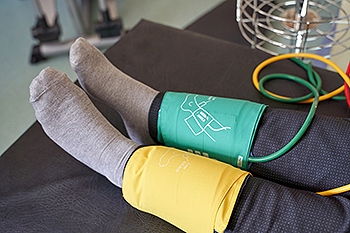Connect With Us
Blog

Specific ways of walking, known as gait, affect how the feet, toes, and ankles bear weight. When pain appears in one area, such as toes, forefoot, midfoot, or heel, the body often shifts pressure to other areas without conscious effort. For instance, heel pain may lead to less pressure at the back of the foot but more under the forefoot. Pain in the arch can cause more force through the middle of the foot to maintain balance. If toes or the ball of the foot hurt, the push-off of each step becomes weaker causing other parts of the foot to take over. This can lead to discomfort in the feet or ankles. A podiatrist can carefully evaluate your gait, or walking pattern, identify where pressure is uneven, and recommend treatment to bring balance back to your foot function. If you have foot pain that may be related to changes in gait, it is suggested that you schedule an appointment with a podiatrist for an exam and appropriate treatment.
If you have any concerns about your feet, contact one of our podiatrists from Foot & Ankle Medical Center . Our doctors can provide the care you need to keep you pain-free and on your feet.
Biomechanics in Podiatry
Podiatric biomechanics is a particular sector of specialty podiatry with licensed practitioners who are trained to diagnose and treat conditions affecting the foot, ankle and lower leg. Biomechanics deals with the forces that act against the body, causing an interference with the biological structures. It focuses on the movement of the ankle, the foot and the forces that interact with them.
A History of Biomechanics
- Biomechanics dates back to the BC era in Egypt where evidence of professional foot care has been recorded.
- In 1974, biomechanics gained a higher profile from the studies of Merton Root, who claimed that by changing or controlling the forces between the ankle and the foot, corrections or conditions could be implemented to gain strength and coordination in the area.
Modern technological improvements are based on past theories and therapeutic processes that provide a better understanding of podiatric concepts for biomechanics. Computers can provide accurate information about the forces and patterns of the feet and lower legs.
Understanding biomechanics of the feet can help improve and eliminate pain, stopping further stress to the foot.
If you have any questions please feel free to contact our office located in Nampa, ID Fruitlland, ID . We offer the newest diagnostic and treatment technologies for all your foot and ankle needs.

Peripheral artery disease, or PAD, is a condition in which narrowed arteries reduce blood flow to the lower limbs, particularly the feet and toes. This can cause pain while walking, slower healing of foot wounds, skin discoloration, and a sensation of cold feet. Testing for PAD typically begins with a podiatrist examining the feet for poor circulation, weak pulses, or changes in skin texture. One common diagnostic tool is the ankle-brachial index, which compares blood pressure at the ankle and the arm to assess blood flow. Additional testing, such as Doppler ultrasound, may be used to detect blocked or narrowed arteries in the lower legs. Identifying PAD early is important to help avoid more serious complications, such as infected ulcers or the need for surgery. People with diabetes, high cholesterol, or a history of smoking may be more likely to develop this condition. If you have symptoms of peripheral artery disease, it is suggested that you schedule an appointment with a podiatrist for a diagnostic testing and suggested treatment.
Vascular testing plays an important part in diagnosing disease like peripheral artery disease. If you have symptoms of peripheral artery disease, or diabetes, consult with one of our podiatrists from Foot & Ankle Medical Center . Our doctors will assess your condition and provide you with quality foot and ankle treatment.
What Is Vascular Testing?
Vascular testing checks for how well blood circulation is in the veins and arteries. This is most often done to determine and treat a patient for peripheral artery disease (PAD), stroke, and aneurysms. Podiatrists utilize vascular testing when a patient has symptoms of PAD or if they believe they might. If a patient has diabetes, a podiatrist may determine a vascular test to be prudent to check for poor blood circulation.
How Is it Conducted?
Most forms of vascular testing are non-invasive. Podiatrists will first conduct a visual inspection for any wounds, discoloration, and any abnormal signs prior to a vascular test.
The most common tests include:
- Ankle-Brachial Index (ABI) examination
- Doppler examination
- Pedal pulses
These tests are safe, painless, and easy to do. Once finished, the podiatrist can then provide a diagnosis and the best course for treatment.
If you have any questions, please feel free to contact our office located in Nampa, ID Fruitlland, ID . We offer the newest diagnostic and treatment technologies for all your foot care needs.

Falls in older adults are often linked to underlying foot conditions that can impair balance, strength, and coordination. Issues such as numbness, joint stiffness, weak ankles, and pain from deformities like bunions or hammertoes may increase the risk of losing balance while walking. Improperly fitting shoes or worn soles can further compromise footing. Addressing these problems can significantly reduce the risk of falls. A podiatrist can assess your foot structure, diagnose conditions affecting mobility, and recommend proper footwear or custom orthotics to improve support. For those with nerve damage or poor circulation in the feet, early detection and treatment are essential to maintaining balance. In some cases, surgery may be advised to correct structural issues that impair gait. Regular foot exams can also help detect progressive conditions before they contribute to instability. If you have foot problems that are likely to contribute to a fall, it is suggested that you schedule an appointment with a podiatrist for expert advice and guidance.
Preventing falls among the elderly is very important. If you are older and have fallen or fear that you are prone to falling, consult with one of our podiatrists from Foot & Ankle Medical Center . Our doctors will assess your condition and provide you with quality advice and care.
Every 11 seconds, an elderly American is being treated in an emergency room for a fall related injury. Falls are the leading cause of head and hip injuries for those 65 and older. Due to decreases in strength, balance, senses, and lack of awareness, elderly persons are very susceptible to falling. Thankfully, there are a number of things older persons can do to prevent falls.
How to Prevent Falls
Some effective methods that older persons can do to prevent falls include:
- Enrolling in strength and balance exercise program to increase balance and strength
- Periodically having your sight and hearing checked
- Discuss any medications you have with a doctor to see if it increases the risk of falling
- Clearing the house of falling hazards and installing devices like grab bars and railings
- Utilizing a walker or cane
- Wearing shoes that provide good support and cushioning
- Talking to family members about falling and increasing awareness
Falling can be a traumatic and embarrassing experience for elderly persons; this can make them less willing to leave the house, and less willing to talk to someone about their fears of falling. Doing such things, however, will increase the likelihood of tripping or losing one’s balance. Knowing the causes of falling and how to prevent them is the best way to mitigate the risk of serious injury.
If you have any questions, please feel free to contact our office located in Nampa, ID Fruitlland, ID . We offer the newest diagnostic and treatment technologies for all your foot care needs.

A foot fracture is a break in one or more bones of the foot, often caused by trauma, overuse, falls, or direct impact from heavy objects. Symptoms typically include sharp pain, swelling, bruising, difficulty walking, and tenderness when pressure is applied. Diagnosis begins with a thorough physical examination, followed by X-rays or digital scans to determine the location and severity of the fracture. A podiatrist plays a key role in identifying the type of fracture and providing appropriate treatment, which may include immobilization, custom orthotics, or surgery. If you have symptoms of a broken foot, it is suggested that you consult with this type of doctor who can accurately diagnose and treat foot fractures.
A broken foot requires immediate medical attention and treatment. If you need your feet checked, contact one of our podiatrists from Foot & Ankle Medical Center . Our doctors can provide the care you need to keep you pain-free and on your feet.
Broken Foot Causes, Symptoms, and Treatment
A broken foot is caused by one of the bones in the foot typically breaking when bended, crushed, or stretched beyond its natural capabilities. Usually the location of the fracture indicates how the break occurred, whether it was through an object, fall, or any other type of injury.
Common Symptoms of Broken Feet:
- Bruising
- Pain
- Redness
- Swelling
- Blue in color
- Numbness
- Cold
- Misshapen
- Cuts
- Deformities
Those that suspect they have a broken foot shoot seek urgent medical attention where a medical professional could diagnose the severity.
Treatment for broken bones varies depending on the cause, severity and location. Some will require the use of splints, casts or crutches while others could even involve surgery to repair the broken bones. Personal care includes the use of ice and keeping the foot stabilized and elevated.
If you have any questions please feel free to contact our office located in Nampa, ID Fruitlland, ID . We offer the newest diagnostic and treatment technologies for all your foot and ankle needs.
